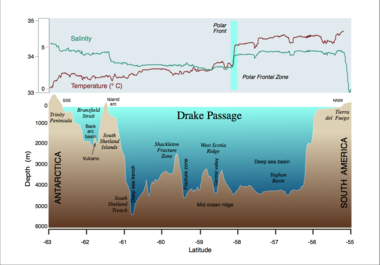Portal:Geography
2008/9 Schools Wikipedia Selection. Related subjects: Geography; Portals
Yarralumla is a large suburb within Canberra, the capital city of Australia. Located approximately 3.5 kilometres south-west of the city centre, Yarralumla extends along the southern bank of Lake Burley Griffin. Europeans first settled the area in 1828, and it was named Yarralumla in 1834 from the Ngunnwal Indigenous Australian name for the area. Yarralumla is most noted for being the site of Government House, the official residence of the Governor-General of Australia, built in 1891. The suburb was officially gazetted in 1928 and today is home to approximately 3000 people and many diplomatic missions. In recent years, it has become one of Canberra's most desirable and expensive suburbs because of its leafy streets, attractive lakeside setting and central location. (more...)
|
Profile through the Drake Passage between South America and the Antarctic Peninsula. Morphological main features in the deep sea are shown like the mid-ocean ridge (West Scotia Ridge), separating the Antarctic Plate from the South American Plate. The South Shetland Islands belong to an island belt, resulting from the subduction of the Pacific plate below the Antarctic plate. In the back arc basin, i.e. the Bransfield Strait, submarine volcanoes have been found. The upper graph shows salinity and temperature in surface water measured along a cruise track. The Polar front is an oceanographic feature which is characterized by a steep change in temperature by some degree. Image credit: Hannes Grobe |
- ...that sandstone layers (pictured) now exposed in the Canyons of the Escalante in Utah were deposited during the Mesozoic period, when the area was covered with sand dunes about 180 to 225 million years ago?
- ...that the Firth of Clyde is Great Britain's first seabird reserve?
- ...that Amsterdam has a concentric belt of canals around it?
- ...that the Korotoa River, a small stream in Rajshahi Division of Bangladesh, was once a large and sacred river?
- ...that Belgium's sillon industriel (steelmaking) was the first fully industrialized area in continental Europe?


